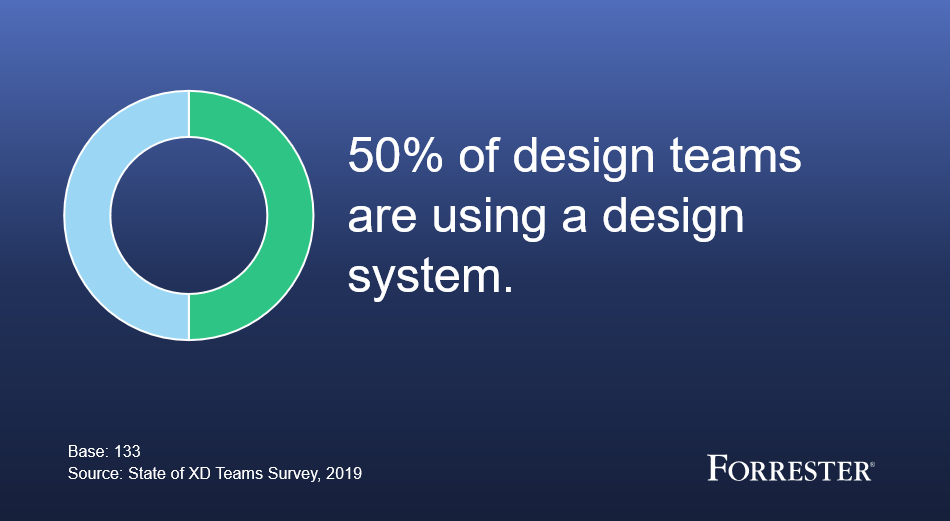Fifty percent. That’s the percentage of design professionals who say their company now uses a design system according to our 2019 State Of Design Team’s survey. And a whopping 74% of those companies say they use a design system more than two years ago. Over a third even have dedicated roles or teams to support establishing, maintaining, and evangelizing their design systems.
Why are companies creating design systems?
More companies are embracing design systems — the principles, templates, components (design and code) that guide a company’s design efforts — to drive a more cohesive experience across channels, power accessibility efforts, increase designer and developer efficiency, and unlock the other benefits we laid out in one of our previous posts, “You Need A Design System — Here’s Why.”
Why would you want help?
There are many design systems companies can take inspiration from — like Google’s Material, Shopify’s Polaris, Adobe’s Spectrum, and Atlassian’s design language system. But building a design system of your own can feel daunting. This is why some design teams turn to external services firms to help.
We often hear from clients that it’s hard to devote cycles of energy to getting this kind of initiative off the ground and evangelizing its value to drive adoption. Many of the services firms have done this tens or even hundreds of times and have experience working with the major tools for managing a design system — like those from Invision, Adobe, and Figma — or with bespoke (possibly Frankensteined) internal tools.
Where should you go for help?
On an ongoing basis, we research the landscape of services firms that help companies with experience design (XD) work — we call them XD providers. And the XD providers about which we hear the most positive feedback about their design systems expertise from clients or design system vendors are:
- 8Shapes
- Big Medium
- Frog
- Huge
- IBM iX
- Idean (part of Capgemini Invent)
- Publicis Sapient
- Punchcut
- SuperFriendly
What should you consider when selecting a partner?
Forrester’s report on XD providers lays out ground rules for selecting and working with these kinds of services firms.
When you contract with an XD provider, always make sure to integrate as closely as possible with them and plan to bring the maintenance, training, and evangelizing of the design system in-house. Your XD provider should feel like part of your team. And your own people should feel as much ownership over the results as the services firm you contract with. Consider even co-locating or scheduling multiple check-ins per day.
When you need help from your XD provider for a design system specifically, ask them questions like:
- “How will you help us prioritize where to start with our design system?” Make sure they talk about how they’ll identify a pilot — this is key to getting an organization exposed to this way of designing and also key for long-term adoption.
- “What kind of user research (internal and external), testing, and internal reviews will we need to conduct?” Be suspicious if your XD provider doesn’t raise this on their own or offers vague answers. There’s huge risk in developing a design system without fully understanding the environment it will be used in and having accurate expectations about the internal resources required.
- “What resources will you bring to the project?” The best design systems are developed in partnership between designers (who understand the coding language for the products the system will support), developers, content strategists, researchers (to user-test the components in the system), and accessibility experts.
- “Do you have expertise in designing and coding to the globally recognized Web Content Accessibility Guidelines (WCAG)?” (Note: Although the guidelines are called web guidelines, they actually apply to software applications and mobile apps as well.) This is crucial because a design system is the best way to bake accessibility into your experiences so you avoid legal risk and improve CX for groups like people with disabilities, the aging population, people with temporary disabilities, and more (see our report about this: “The Inclusive Design Imperative”).
- “How will you help us gain adoption for the system?” Many clients tell us building the system is the easier part — gaining adoption among users is much harder. Look for an XD provider that can help you with that part too, not just ship a system.
- “How will you engage the users of the design system (our designers, developers, etc.) in the project?” This is key for long-term adoption.
- “How will we know whether the design system is having the intended impact?” Make sure you (or you with your XD provider) create a plan to measure the impact of the system on the customer experience (CX metrics), users (e.g., is it saving designers and developers time so they can contribute to more projects?) and the business (e.g., are you getting products to market faster and are you eliminating waste in your development process?).
Have you worked with an XD provider on your design system? If so, we’d love to interview you about your experience! Contact Gina at [email protected] or Andrew at [email protected].
